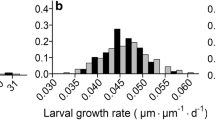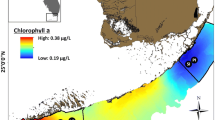Abstract
In fishes, the growth-mortality hypothesis has received broad acceptance as a driver of recruitment variability. Recruitment is likely to be lower in years when the risk of starvation and predation in the larval stage is greater, leading to higher mortality. Juvenile snapper, Pagrus auratus (Sparidae), experience high recruitment variation in Port Phillip Bay, Australia. Using a 5-year (2005, 2007, 2008, 2010, 2011) data set of larval and juvenile snapper abundances and their daily growth histories, based on otolith microstructure, we found selective mortality acted on larval size at 5 days post-hatch in 4 low and average recruitment years. The highest recruitment year (2005) was characterised by no size-selective mortality. Larval growth of the initial larval population was related to recruitment, but larval growth of the juveniles was not. Selective mortality may have obscured the relationship between larval traits of the juveniles and recruitment as fast-growing and large larvae preferentially survived in lower recruitment years and fast growth was ubiquitous in high recruitment years. An index of daily mortality within and among 3 years (2007, 2008, 2010), where zooplankton were concurrently sampled with ichthyoplankton, was related to per capita availability of preferred larval prey, providing support for the match–mismatch hypothesis. In 2010, periods of low daily mortality resulted in no selective mortality. Thus both intra- and inter-annual variability in the magnitude and occurrence of selective mortality in species with complex life cycles can obscure relationships between larval traits and population replenishment, leading to underestimation of their importance in recruitment studies.






Similar content being viewed by others
References
Anderson JT (1988) A review of size dependent survival during pre-recruit stages of fishes in relation to recruitment. J Northwest Atl Fish Sci 8:55–66
Bailey KM, Houde ED (1989) Predation on eggs and larvae of marine fishes and the recruitment problem. Adv Mar Biol 25:1–83
Bastow TP, Jackson G, Edmonds JS (2002) Elevated salinity and isotopic composition of fish otolith carbonate: stock delineation of snapper, Pagrus auratus, in Shark Bay, Western Australia. Mar Biol 141:801–806
Battaglene SC, Talbot RB (1992) Induced spawning and larval rearing of snapper, Pagrus auratus (Pisces, Sparidae), from Australian waters. N Z J Mar Freshwater Res 26:179–183
Bertram DF, Leggett WC (1994) Predation risk during the early-life history periods of fishes: separating the effects of size and age. Mar Ecol Prog Ser 109:105–114
Biro PA, Abrahams MV, Post JR, Parkinson EA (2004) Predators select against high growth rates and risk-taking behaviour in domestic trout populations. Proc R Soc Lond B Biol Sci 271:2233–2237. doi:10.1098/rspb.2004.2861
Black K, Hatton D, Rosenberg M (1993) Locally and externally-driven dynamics of a large semi-enclosed bay in southern Australia. J Coast Res 9:509–538
Campana SE (1996) Year-class strength and growth rate in young Atlantic cod Gadus morhua. Mar Ecol Prog Ser 135:21–26
Chambers RC, Waiwood KG (1996) Maternal and seasonal differences in egg sizes and spawning characteristics of captive Atlantic cod, Gadus morhua. Can J Fish Aquat Sci 53:1986–2003. doi:10.1139/f96-141
Coutin PC, Cashmore S, Sivakumuran KP (2003) Assessment of the Snapper Fishery in Victoria. Marine and Freshwater Resources Institute, Queenscliff. Project No 97/127. Fisheries Research and Development Corporation, Canberra, Australia
Crean AJ, Monro K, Marshall DJ (2011) Fitness consequences of larval traits persist across the metamorphic boundary. Evolution 65:3079–3089. doi:10.1111/j.1558-5646.2011.01372.x
Cushing DH (1972) The production cycle and the numbers of marine fish. Symp Zool Soc Lond 29:213–232
Cushing DH (1975) Marine ecology and fisheries. Cambridge University Press, Cambridge
Cushing DH (1990) Plankton production and year-class strength in fish populations: an update of the match/mismatch hypothesis. Adv Mar Biol 29:250–293
D’Alessandro EK, Sponaugle S, Cowen RK (2013) Selective mortality during the larval and juvenile stages of snappers (Lutjanidae) and great barracuda Sphyraena barracuda. Mar Ecol Prog Ser 474:227–242
Fancett MS, Jenkins GP (1988) Predatory impact of scyphomedusae on ichthyoplankton and other zooplankton in Port Phillip Bay. J Exp Mar Biol Ecol 116:63–77
Fowler AJ, Jennings PR (2003) Dynamics in 0 + recruitment and early life history for snapper (Pagrus auratus, Sparidae) in South Australia. Mar Freshwater Res 54:941–956
Francis MP (1994a) Duration of larval and spawning periods of Pagrus auratus (Sparidae) determined from otolith daily increments. Environ Biol Fishes 39:137–152
Francis MP (1994b) Growth of juvenile snapper, Pagrus auratus. N Z J Mar Freshwater Res 28:201–218
Gagliano M, McCormick MI, Meekan MG (2007) Survival against the odds: ontogenetic changes in selective pressure mediate growth-mortality trade-offs in a marine fish. Proc R Soc Lond B Biol Sci 274:1575–1582. doi:10.1098/rspb.2007.0242
Gaughan D, Moran MD, Ranaldi M, Watling J (2003) Identifying nursery areas used by inner bay and oceanic snapper (Pagrus auratus) stocks in the Shark Bay region, in relation to the effect of prawn trawling on inner bay snapper stocks. Department of Fisheries. Fisheries and Research Development Corporation final report, project 2002/061, Perth
Green BS, McCormick MI (2005) Maternal and paternal effects determine size, growth and performance in larvae of a tropical reef fish. Mar Ecol Prog Ser 289:263–272
Grorud-Colvert K, Sponaugle S (2010) Variability in water temperature affects trait-mediated survival of a newly settled coral reef fish. Oecologia 165:675–686. doi:10.1007/s00442-010-1748-4
Hamer PA, Jenkins GP (2004) High levels of spatial and temporal recruitment variability in the temperate sparid Pagrus auratus. Mar Freshwater Res 55:663–673
Hamer PA, Jenkins GP, Welsford DC (1998) Sampling of newly-settled snapper, Pagrus auratus, and identification of preferred habitats in Port Phillip Bay—a pilot study. Project number 96/279. Fisheries Research and Development Corporation, Canberra, Australia
Hamer PA, Jenkins GP, Acevedo S (2010) Importance of spawning in Port Phillip Bay to local snapper stocks. Fisheries Victoria Research Branch, no. 37, Queenscliff, Victoria
Hamer PA, Acevedo S, Jenkins GP, Newman A (2011) Connectivity of a large embayment and coastal fishery: spawning aggregations in one bay source local and broad-scale fishery replenishment. J Fish Biol 78:1090–1109
Hare JA, Cowen RK (1997) Size, growth, development, and survival of the planktonic larvae of Pomatomus saltatrix (Pisces: Pomatomidae). Ecology 78:2415–2431
Hellmann C, Winkelmann C, Worischka S, Benndorf J (2011) Extended larval development compensates for sublethal effects of fish predation in a mayfly population (Rhithrogena semicolorata, Ephemeroptera). Limnologica 41:256–265
Houde ED (1987) Fish early life dynamics and recruitment variability. Am Fish Soc Symp 2:17–29
Islam MS, Ueno M, Yamashita Y (2010) Growth-dependent survival mechanisms during the early life of a temperate seabass (Lateolabrax japonicus): field test of the ‘growth-mortality’ hypothesis. Fisher Oceanogr 19:230–242. doi:10.1111/j.1365-2419.2010.00539.x
Jenkins GP (1986) Composition, seasonality and distribution of ichthyoplankton in Port Phillip Bay, Victoria. Aust J Mar Freshwater Res 37:507–520
Jenkins GP, Hatton D (2007) Modelling of larval King George whiting and snapper dispersal under the RL 22-m depth scenario, no. 97. Primary Industries Research Victoria, Queenscliff
Joh M, Nakaya M, Yoshida N, Takatsu T (2013) Interannual growth differences and growth-selective survival in larvae and juveniles of marbled sole Pseudopleuronectes yokohamae. Mar Ecol Prog Ser 494:267–279
Kamler E (2005) Parent–egg–progeny relationships in teleost fishes: an energetics perspective. Rev Fish Biol Fish 15:399–421
Kemp J, Conron S, Hamer PA, Bruce TB, Brown L (2012) Victorian snapper stock assessment 2011. Fisheries Victoria assessment report reries no. 64, Queenscliff
Marteinsdottir G, Steinarsson A (1998) Maternal influence on the size and viability of Iceland cod Gadus morhua eggs and larvae. J Fish Biol 52:1241–1258. doi:10.1111/j.1095-8649.1998.tb00969.x
McCormick MI, Hoey AS (2004) Larval growth history determines juvenile growth and survival in a tropical marine fish. Oikos 106:225–242
Meekan MG, Fortier L (1996) Selection for fast growth during the larval life of Atlantic cod Gadus morhua on the Scotian Shelf. Mar Ecol Prog Ser 137:25–37
Meekan MG, Vigliola L, Hansen A, Doherty PJ, Halford A, Carleton JH (2006) Bigger is better: size-selective mortality throughout the life history of a fast-growing clupeid, Spratelloides gracilis. Mar Ecol Prog Ser 317:237–244
Murphy HM, Jenkins GP, Hamer PA, Swearer SE (2012) Interannual variation in larval survival of snapper (Chrysophrys auratus, Sparidae) is linked to diet breadth and prey availability. Can J Fish Aquat Sci 69:1340–1351
Murphy HM, Jenkins GP, Hamer PA, Swearer SE (2013) Interannual variation in larval abundance and growth in snapper, Chrysophrys auratus Sparidae, is related to prey availability and temperature. Mar Ecol Prog Ser 487:151–162. doi:10.3354/meps10388
Nahas EL, Jackson G, Pattiaratchi CB, Ivey GN (2003) Hydrodynamic modelling of snapper Pagrus auratus egg and larval dispersal in Shark Bay, Western Australia: reproductive isolation at a fine spatial scale. Mar Ecol Prog Ser 265:213–226
Rankin TL, Sponaugle S (2011) Temperature influences selective mortality during the early life stages of a coral reef fish. PLoS ONE 6:e16814
Raventos N, Macpherson E (2005) Effect of pelagic larval growth and size-at-hatching on post-settlement survivorship in two temperate labrid fish of the genus Symphodus. Mar Ecol Prog Ser 285:205–211
Ricker WE (1975) Compilation and interpretation of biological statistics of fish populations. Fish Res Bd Can Bull 191
Robert D, Castonguay M, Fortier L (2007) Early growth and recruitment in Atlantic mackerel Scomber scombrus: discriminating the effects of fast growth and selection for fast growth. Mar Ecol Prog Ser 337:209–219
Robert D, et al. (2010) Predation dynamics of mackerel on larval and juvenile anchovy: is capture success linked to prey condition? Fish Sci 76:183–188. doi:10.1007/s12562-009-0205-y
Scott SG, Zeldis JR, Pankhurst NW (1993) Evidence of daily spawning in natural populations of the New Zealand snapper Pagrus auratus (Sparidae). Environ Biol Fishes 36:149–156. doi:10.1007/bf00002794
Searcy SP, Sponaugle S (2001) Selective mortality during the larval-juvenile transition in two coral reef fishes. Ecology 82:2452–2470. doi:10.1890/0012-9658(2001)082[2452:smdtlj]2.0.co;2
Smith AC, Shima JS (2011) Variation in the effects of larval history on juvenile performance of a temperate reef fish. Aust Ecol 36:830–838
Sogard SM (1997) Size-selective mortality in the juvenile stage of teleost fishes: a review. Bull Mar Sci 60:1129–1157
Sponaugle S, Boulay JN, Rankin TL (2011) Growth- and size-selective mortality in pelagic larvae of a common reef fish. Aquat Biol 13:263–273. doi:10.3354/ab00370
Tanaka Y, Satoh K, Yamada H, Takebe T, Nikaido H, Shiozawa S (2008) Assessment of the nutritional status of field-caught larval Pacific bluefin tuna by RNA/DNA ratio based on a starvation experiment of hatchery-reared fish. J Exp Mar Biol Ecol 354:56–64. doi:10.1016/j.jembe.2007.10.007
Van Allen B, Briggs V, McCoy M, Vonesh J (2010) Carry-over effects of the larval environment on post-metamorphic performance in two hylid frogs. Oecologia 164:891–898. doi:10.1007/s00442-010-1728-8
Vigliola L, Meekan MG (2002) Size at hatching and planktonic growth determine post-settlement survivorship of a coral reef fish. Oecologia 131:89–93
Wilbur HM (1980) Complex life cycles. Annu Rev Ecol Syst 11:67
Zeldis JR, Oldman J, Ballara SL, Richards LA (2005) Physical fluxes, pelagic ecosystem structure, and larval fish survival in Hauraki Gulf, New Zealand. Can J Fish Aquat Sci 62:593–610
Acknowledgments
We would like to acknowledge Silvana Acevedo, Dean Chamberlain, Julia Kent, Andrew Brown, Tim Kenner, Jessica Hommelhoff, Annique Harris, and Camila Martins for help in the field and laboratory. Fish Ageing Services prepared the juvenile otoliths for age analysis. The manuscript was greatly improved by the comments from two anonymous reviewers. This project was funded by an Australian Research Council Linkage Grant (LP0989432) between the Department of Primary Industries, Fisheries Victoria, and the University of Melbourne. Port of Melbourne Corporation was an additional funding source.
Author information
Authors and Affiliations
Corresponding author
Additional information
Communicated by Tony Underwood.
Rights and permissions
About this article
Cite this article
Murphy, H.M., Warren-Myers, F.W., Jenkins, G.P. et al. Variability in size-selective mortality obscures the importance of larval traits to recruitment success in a temperate marine fish. Oecologia 175, 1201–1210 (2014). https://doi.org/10.1007/s00442-014-2968-9
Received:
Accepted:
Published:
Issue Date:
DOI: https://doi.org/10.1007/s00442-014-2968-9




